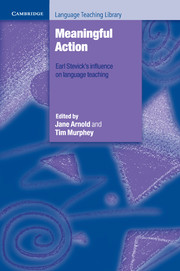Book contents
- Frontmatter
- Contents
- List of contributors
- Acknowledgements
- Preface
- Introduction
- Part A Meaning-making inside and between the people in the classroom
- Part B Meaningful classroom activity
- Part C Frameworks for meaningful language learning
- Epilogue: A way with words – perspectives on the contributions and influence of Earl W. Stevick
- Appendix: Words of tribute to Earl Stevick
- Index
4 - The learning body
Published online by Cambridge University Press: 15 November 2023
- Frontmatter
- Contents
- List of contributors
- Acknowledgements
- Preface
- Introduction
- Part A Meaning-making inside and between the people in the classroom
- Part B Meaningful classroom activity
- Part C Frameworks for meaningful language learning
- Epilogue: A way with words – perspectives on the contributions and influence of Earl W. Stevick
- Appendix: Words of tribute to Earl Stevick
- Index
Summary
Hands, do what you’re bid:
Bring the balloon of the mind
That bellies and drags in the wind
Into its narrow shed.
(W. B. Yeats)Introduction
The humanist tradition has provided a useful corrective to the view that learning, whether of languages or of anything else, is primarily an intellectual endeavour. As Williams and Burden (1997: 30) note, ‘Humanism provides an added dimension … in that it emphasises the development of the whole person rather than focusing solely upon the development and employment of cognitive skills’, the whole person being understood as including ‘the individual's thoughts, feelings and emotions’. If the strictly mentalist, Cartesian view could be paraphrased as ‘I think, therefore I learn’, the humanist view is more ‘I think, feel and desire, therefore I learn.’
The humanist concern for the person, however, does not (or should not) ignore the people. The dual focus of language learning, both on the (inner) person and on the people (in the room), is well captured in Stevick's oft-cited assertion that ‘success depends less on materials, techniques, and linguistic analyses, and more on what goes on inside and between the people in the classroom’ (1980: 4). In so doing, he invokes ‘a world of meaningful action’ within which the learning experience is situated.
In this chapter I want to extend this line of thought by arguing that language – and hence both language use and language learning – is both embodied by, and physically embedded in its contexts of use, and that what happens between people and within them is all part of a seamless process, by which the learning mind extends far beyond its ‘narrow shed’. Or, as Churchill et al. (2010: 237) put it, ‘brains are in bodies, bodies are in the world, and meaningful action in these worlds is in large part socially constructed and conducted’.
The theoretical model which I shall adopt is a dynamical systemsbased, ecologically oriented one, generally known now as situated cognition, which takes the position that ‘human cognitive processes are inherently social, interactive, personal, biological, and neurological, which is to say that a variety of systems develop and depend on one another in complex ways’ (Clancey 2009: 11).
- Type
- Chapter
- Information
- Meaningful ActionEarl Stevick's Influence on Language Teaching, pp. 62 - 78Publisher: Cambridge University PressPrint publication year: 2013
- 1
- Cited by

